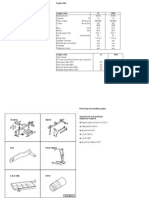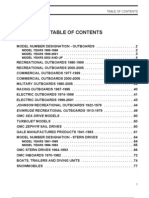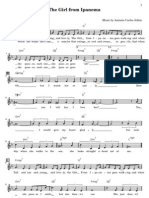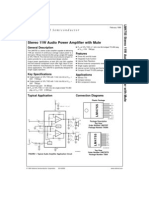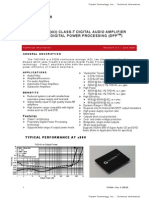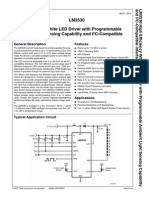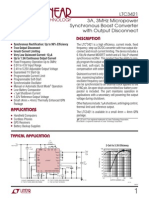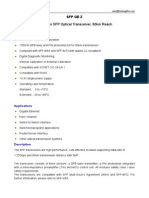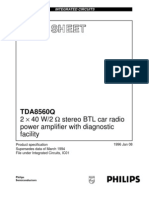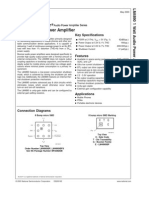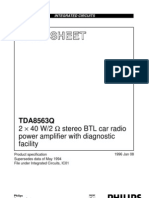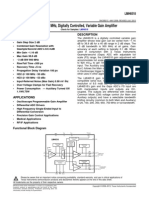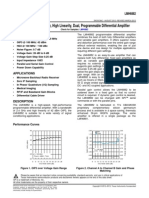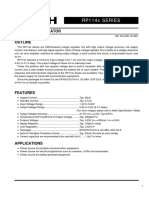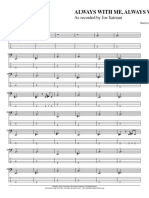LM4811 Dual 105mW Headphone Amplifier With Digital Volume Control and Shutdown Mode
LM4811 Dual 105mW Headphone Amplifier With Digital Volume Control and Shutdown Mode
Uploaded by
Buga BuniciCopyright:
Available Formats
LM4811 Dual 105mW Headphone Amplifier With Digital Volume Control and Shutdown Mode
LM4811 Dual 105mW Headphone Amplifier With Digital Volume Control and Shutdown Mode
Uploaded by
Buga BuniciOriginal Description:
Original Title
Copyright
Available Formats
Share this document
Did you find this document useful?
Is this content inappropriate?
Copyright:
Available Formats
LM4811 Dual 105mW Headphone Amplifier With Digital Volume Control and Shutdown Mode
LM4811 Dual 105mW Headphone Amplifier With Digital Volume Control and Shutdown Mode
Uploaded by
Buga BuniciCopyright:
Available Formats
LM4811 Dual 105mW Headphone Amplifier with Digital Volume Control and Shutdown Mode
April 2006
LM4811 Dual 105mW Headphone Amplifier with Digital Volume Control and Shutdown Mode
General Description
The LM4811 is a dual audio power amplifier capable of delivering 105mW per channel of continuous average power into a 16 load with 0.1% (THD+N) from a 5V power supply. Boomer audio power amplifiers were designed specifically to provide high quality output power with a minimal amount of external components. Since the LM4811 does not require bootstrap capacitors or snubber networks, it is optimally suited for low-power portable systems. The LM4811 features a digital volume control that sets the amplifiers gain from +12dB to 33dB in 16 discrete steps using a twowire interface. The unity-gain stable LM4811 also features an externally controlled, active-high, micropower consumption shutdown mode. It also has an internal thermal shutdown protection mechanism.
Key Specifications
j THD+N at 1kHz, 105mW continuous
average output power into 16
j THD+N at 1kHz, 70mW continuous
0.1% (typ) 0.1% (typ) 0.3A (typ)
average power into 32
j Shutdown Current
Features
n n n n n Digital volume control range from +12dB to 33dB LD and MSOP surface mount packaging "Click and Pop" suppression circuitry No bootstrap capacitors required Low shutdown current
Applications
n n n n Cellular Phones MP3, CD, DVD players PDAs Portable electronics
Connection Diagrams
MSOP Package
LD Package
20006102
Top View Order Number LM4811MM See NS Package Number MUB10A
20006162
Top View Order Number LM4811LD See NS Package Number LDA10A
Boomer is a registered trademark of National Semiconductor Corporation.
2006 National Semiconductor Corporation
DS200061
www.national.com
LM4811
Connection Diagrams
YD Package
(Continued) YD Marking
20006167
20006162
Top View Z - Plant Code XY - Date Code TT - Die Traceability L4811 - LM4811YD
Top View Order Number LM4811YD See NS Package Number YDA10A
www.national.com
LM4811
Typical Application
20006101
*Refer to the Application Information Section for information concerning proper selection of the input and output coupling capacitors.
FIGURE 1. Typical Audio Amplifier Application Circuit
www.national.com
LM4811
Absolute Maximum Ratings (Note 1)
If Military/Aerospace specified devices are required, please contact the National Semiconductor Sales Office/ Distributors for availability and specifications. Supply Voltage Storage Temperature ESD Susceptibility (Note 3) ESD Susceptibility Machine model (Note 6) Junction Temperature (TJ) Soldering Information Small Outline Package Vapor Phase (60 sec.) Infrared (15 sec.) 215C 220C 6.0V 65C to +150C 2.5kV 200V 150C
Thermal Resistance JA MUB10A JC MUB10A JA LDA10A (Note 7) JC LDA10A (Note 7) JA YDA10A (Note 7) JC YDA10A (Note 7) 194C/W 52C/W 63C/W 12C/W 63C/W 12C/W
Operating Ratings
Temperature Range TMIN TA TMAX Supply Voltage 40C T
A
85C
2.0V VCC 5.5V
Electrical Characteristics (Notes 1, 8)
The following specifications apply for VDD = 5V unless otherwise specified, limits apply to TA = 25C. Symbol Parameter Conditions LM4811 Typical (Note 4) VDD IDD ISD VOS PO Supply Voltage Supply Current Shutdown Current Output Offset Voltage Output Power VIN = 0V, IO = 0A VIN = 0V VIN = 0V 0.1% THD+N; f = 1kHz RL = 16 RL = 32 THD+N Total Harmonic Distortion PO = 50mW, RL = 32 f = 20Hz to 20kHz RL = 32; f = 1kHz; PO = 70mW CB = 1.0F, VRIPPLE = 100mVPP f = 217Hz 105 70 0.3 100 60 1.4 0.4 Input referred minimum gain Input referred maximum gain Digital Volume Stepsize Stepsize Error ChanneltoChannel Volume Tracking Error Shutdown Attenuation All 16 discrete steps All 16 discrete steps All gain settings from 33dB to +12dB Shutdown mode active 33 +12 3.0 mW mW % dB dB V (min) V (max) dB dB dB dB dB dB 1.3 0.3 4.0 50 Limit (Note 5) 2.0 5.5 3.0 Units (Limits) V (min) V (max) mA A mV
Crosstalk Channel Separation PSRR VIH VIL Power Supply Rejection Ratio (CLOCK, UP/DN, SHUTDOWN) Input Voltage High (CLOCK, UP/DN, SHUTDOWN) Input Voltage Low Digital Volume Range
0.3
0.15 100
www.national.com
LM4811
Electrical Characteristics (Notes 1, 8)
The following specifications apply for VDD = 3.3V unless otherwise specified, limits apply to TA = 25C. Symbol Parameter Conditions LM4811 Typical (Note 4) IDD ISD VOS Po Supply Current Shutdown Current Output Offset Voltage Output Power VIN = 0V, IO = 0A VIN = 0V VIN = 0V 0.1% THD+N; f = 1kHz RL = 16 RL = 32 THD+N PSRR VIH VIL Total Harmonic Distortion Power Supply Rejection Ratio (CLOCK, UP/DN, SHUTDOWN) Input Voltage High (CLOCK, UP/DN, SHUTDOWN) Input Voltage Low Digital Volume Range Digital Volume Stepsize Stepsize Error ChanneltoChannel Volume Tracking Error Shutdown Attenuation Input referred minimum gain Input referred maximum gain All 16 discrete steps All 16 discrete steps All gain settings from 33dB to +12dB Shutdown mode active PO = 25mW, RL = 32 f = 20Hz to 20kHz CB = 1.0F, VRIPPLE = 100mVPP f = 217Hz 40 28 0.5 60 1.4 0.4 33 +12 3.0 mW mW % dB V (min) V (max) dB dB dB dB dB dB 1.1 0.3 4.0 Limit (Note 5) Units (Limits) mA A mV
0.3
0.15 100
Electrical Characteristics (Notes 1, 8)
The following specifications apply for VDD = 2.6V unless otherwise specified, limits apply to TA = 25C. Symbol Parameter Conditions LM4811 Typical (Note 4) IDD ISD VOS Po Supply Current Shutdown Current Output Offset Voltage Output Power VIN = 0V, IO = 0A VIN = 0V VIN = 0V 0.1% THD+N; f = 1kHz RL = 16 RL = 32 THD+N PSRR VIH VIL Total Harmonic Distortion Power Supply Rejection Ratio (CLOCK, UP/DN, SHUTDOWN) Input Voltage High (CLOCK, UP/DN, SHUTDOWN) Input Voltage Low Digital Volume Range Digital Volume Stepsize Stepsize Error ChanneltoChannel Volume Tracking Error Input referred minimum gain Input referred maximum gain All 16 discrete steps All 16 discrete steps All gain settings from 33dB to +12dB PO = 15mW, RL = 32 f = 20Hz to 20kHz CB = 1.0F, VRIPPLE = 100mVPP f = 217Hz 20 16 0.6 60 1.4 0.4 33 +12 3.0 mW mW % dB V (min) V (max) dB dB dB dB dB 1.0 0.3 4.0 Limit (Note 5) Units (Limits) mA A mV
0.3
0.15
www.national.com
LM4811
Electrical Characteristics (Notes 1, 8)
Symbol Parameter
(Continued) The following specifications apply for VDD = 2.6V unless otherwise specified, limits apply to TA = 25C. Conditions LM4811 Typical (Note 4) Shutdown Attenuation Shutdown mode active 75 Limit (Note 5) Units (Limits) dB
Note 1: Absolute Maximum Ratings indicate limits beyond which damage to the device may occur. Note 2: Operating Ratings indicate conditions for which the device is functional, but do not guarantee specific performance limits. For guaranteed specifications and test conditions, see the Electrical Characteristics. The guaranteed specifications apply only for the test conditions listed. Some performance characteristics may degrade when the device is not operated under the listed test conditions. Note 3: Human body model, 100pF discharged through a 1.5k resistor. Note 4: Typical specifications are specified at +25C and represent the most likely parametric norm. Note 5: Tested limits are guaranteed to Nationals AOQL (Average Outgoing Quality Level). Datasheet min/max specification limits are guaranteed by design, test, or statistical analysis. Note 6: : Machine Model ESD test is covered by specification EIAJ IC-121-1981. A 200pF cap is charged to the specified voltage, then discharged directly into the IC with no external series resistor (resistance of discharge path must be under 50 Ohms). Note 7: The LDA10A or YDA10A package has its ExposedDAP soldered to an exposed 2in2 area of 1oz printed circuit board copper. Note 8: All voltages are measured with respect to the ground pin, unless otherwise specified.
External Components Description
(Figure 1) Components Functional Description This is the input coupling capacitor. It blocks the DC voltage at, and couples the input signal to, the amplifiers input terminals. Ci also creates a highpass filter with the internal input resistor, Ri, at fc = 1/(2RiCi). The minimum value of Ri is 33k. Refer to the section, Proper Selection of External Components, for an explanation of how to determine the value of Ci. This is the supply bypass capacitor. It provides power supply filtering. Refer to the Application Information section for proper placement and selection of the supply bypass capacitor. This is the BYPASS pin capacitor. It provides half-supply filtering. Refer to the section, Proper Selection of External Components, for information concerning proper placement and selection of CB. This is the output coupling capacitor. It blocks the DC voltage at the amplifiers output and it forms a high pass filter with RL at fO = 1/(2R LCO)
1. Ci
2. CS 3. CB 4. CO
www.national.com
LM4811
Typical Performance Characteristics
THD+N vs Frequency THD+N vs Frequency
20006103
20006104
THD+N vs Frequency
THD+N vs Frequency
20006105
20006106
THD+N vs Frequency
THD+N vs Frequency
20006107
20006108
www.national.com
LM4811
Typical Performance Characteristics
THD+N vs Frequency
(Continued) THD+N vs Frequency
20006109
20006110
THD+N vs Frequency
THD+N vs Output Power
20006111
20006112
THD+N vs Output Power
THD+N vs Output Power
20006113
20006114
www.national.com
LM4811
Typical Performance Characteristics
THD+N vs Output Power
(Continued) THD+N vs Output Power
20006115
20006116
THD+N vs Output Power
THD+N vs Output Power
20006117
20006118
THD+N vs Output Power
THD+N vs Output Power
20006119
20006120
www.national.com
LM4811
Typical Performance Characteristics
Output Power vs Load Resistance
(Continued) Output Power vs Load Resistance
20006122
20006123
Output Power vs Load Resistance
Output Power vs Supply Voltage
20006124
20006125
Output Power vs Power Supply
Output Power vs Power Supply
20006126
20006127
www.national.com
10
LM4811
Typical Performance Characteristics
Dropout Voltage vs Supply Voltage
(Continued) Power Dissipation vs Output Power
20006128
20006129
Power Dissipation vs Output Power
Power Dissipation vs Output Power
20006130
20006131
Channel Separation
Channel Separation
20006132
20006133
11
www.national.com
LM4811
Typical Performance Characteristics
Noise Floor
(Continued) Power Supply Rejection Ratio
20006134
20006135
Power Supply Rejection Ratio
Power Supply Rejection Ratio
20006150
20006151
Frequency Response
Supply Current vs Supply Voltage
20006144 20006136
www.national.com
12
LM4811
Application Information
DIGITAL VOLUME CONTROL The LM4811s gain is controlled by the signals applied to the CLOCK and UP/DN inputs. An external clock is required to drive the CLOCK pin. At each rising edge of the clock signal, the gain will either increase or decrease by a 3dB step depending on the logic voltage level applied to the UP/DN pin. A logic high voltage level applied to the UP/DN pin causes the gain to increase by 3dB at each rising edge of the clock signal. Conversely, a logic low voltage level applied to the UP/DN pin causes the gain to decrease 3dB at each rising edge of the clock signal. For both the CLOCK and UP/DN inputs, the trigger point is 1.4V minimum for a logic high level, and 0.4V maximum for a logic low level. There are 16 discrete gain settings ranging from +12dB maximum to 33dB minimum. Upon device power on, the amplifiers gain is set to a default value of 0dB. However, when coming out of shutdown mode, the LM4811 will revert back to its previous gain setting. The LM4811s CLOCK and UP/DN pins should be debounced in order to avoid unwanted state changes during transitions between VIL and VIH. This will ensure correct operation of the digital volume control. A microcontroller or microprocessor output is recommended to drive the CLOCK and UP/DN pins.
For the MSOP package, JA = 194C/W, and for the LD/YD package, JA = 63C/W. TJMAX = 150C for the LM4811. For a given ambient temperature, TA, of the system surroundings, Equation 2 can be used to find the maximum internal power dissipation supported by the IC packaging. If the result of Equation 1 is greater than that of Equation 2, then either the supply voltage must be decreased, the load impedance increased, or TA reduced. For the MSOP package in a typical application of a 5V power supply and a 32 load, the maximum ambient temperature possible without violating the maximum junction temperature is approximately 134.5C. This assumes the device operates at maximum power dissipation and uses surface mount packaging. Internal power dissipation is a function of output power. If typical operation is not around the maximum power dissipation point, operation at higher ambient temperatures is possible. Refer to the Typical Performance Characteristics curves for power dissipation information for lower output power levels. EXPOSED-DAP PACKAGE PCB MOUNTING CONSIDERATION The LM4811s exposed-dap (die attach paddle) package (LD/YD) provides a low thermal resistance between the die and the PCB to which the part is mounted and soldered. This allows rapid heat transfer from the die to the surrounding PCB copper traces, ground plane, and surrounding air. The LD/YD package should have its DAP soldered to a copper pad on the PCB. The DAPs PCB copper pad may be connected to a large plane of continuous unbroken copper. This plane forms a thermal mass, heat sink, and radiation area. However, since the LM4811 is designed for headphone applications, connecting a copper plane to the DAPs PCB copper pad is not required. The LM4811s Power Dissipation vs Output Power Curve in the Typical Performance Characteristics shows that the maximum power dissipated is just 45mW per amplifier with a 5V power supply and a 32 load. Further detailed and specific information concerning PCB layout, fabrication, and mounting an LD/YD (LLP) package is available from National Semiconductors Package Engineering Group under application note AN1187. POWER SUPPLY BYPASSING As with any power amplifier, proper supply bypassing is critical for low noise performance and high power supply rejection. The capacitor location on both the bypass and power supply pins should be as close to the device as possible. The value of the bypass capacitor directly affects the LM4811s half-supply voltage stability and PSRR. The stability and supply rejection increase as the bypass capacitors value increases. Typical applications employ a 5V regulator with 10F and a 0.1F bypass capacitors which aid in supply stability, but do not eliminate the need for bypassing the supply nodes of the LM4811. The selection of bypass capacitors, especially CB, is thus dependent upon desired low frequency PSRR, click and pop performance, (explained in the section, Proper Selection of External Components), system cost, and size constraints. SHUTDOWN FUNCTION In order to reduce power consumption while not is use, the LM4811 features amplifier bias circuitry shutdown. This shutdown function is activated by applying a logic high to the SHUTDOWN pin. The trigger point is 1.4V minimum for a
13 www.national.com
20006157
FIGURE 2. Timing Diagram POWER DISSIPATION Power dissipation is a major concern when using any power amplifier and must be thoroughly understood to ensure a successful design. Equation 1 states the maximum power dissipation point for a single-ended amplifier operating at a given supply voltage and driving a specified output load. PDMAX = (VDD)
2
/ (22RL)
(1)
Since the LM4811 has two operational amplifiers in one package, the maximum internal power dissipation point is twice that of the number which results from Equation 1. Even with the large internal power dissipation, the LM4811 does not require heat sinking over a large range of ambient temperature. From Equation 1, assuming a 5V power supply and a 32 load, the maximum power dissipation point is 40mW per amplifier. Thus the maximum package dissipation point is 80mW. The maximum power dissipation point obtained must not be greater than the power dissipation predicted by Equation 2: PDMAX = (TJMAX TA) / JA (2)
LM4811
Application Information
(Continued)
logic high level, and 0.4V maximum for a logic low level. It is best to switch between ground and VDD to ensure optimal shutdown operation. By switching the SHUTDOWN pin to VDD, the LM4811 supply current draw will be minimized in idle mode. Whereas the device will be disabled with shutdown voltages less than VDD, the idle current may be greater than the typical value of 0.3A. In either case, the SHUTDOWN pin should be tied to a fixed voltage to avoid unwanted state changes. In many applications, a microcontroller or microprocessor output is used to control the shutdown circuitry. This provides a quick, smooth shutdown transition. Another solution is to use a single-pole, single-throw switch in conjunction with an external pull-up resistor. When the switch is closed, the SHUTDOWN pin is connected to ground and enables the amplifier. If the switch is open, the external pull-up resistor, RPU, will disable the LM4811. This scheme guarantees that the SHUTDOWN pin will not float, thus preventing unwanted state changes. PROPER SELECTION OF EXTERNAL COMPONENTS Selection of external components when using integrated power amplifiers is critical for optimum device and system performance. While the LM4811 is tolerant of external component combinations, consideration must be given to the external component values that maximize overall system quality. The LM4811s unity-gain stability allows a designer to maximize system performance. Low gain settings maximize signal-to-noise performance and minimizes THD+N. Low gain configurations require large input signals to obtain a given output power. Input signals equal to or greater than 1 Vrms are available from sources such as audio codecs. Please refer to the section, Audio Power Amplifier Design, for a more complete explanation of proper gain selection. Selection of Input and Output Capacitor Size Besides gain, one of the major considerations is the closed loop bandwidth of the amplifier. To a large extent, the bandwidth is dicated by the choice of external components shown in Figure 1. Both the input coupling capacitor, Ci, and the output coupling capacitor, Co, form first order high pass filters which limit low frequency response. These values should be based on the desired frequency response weighed against the following: Large value input and output capacitors are both expensive and space consuming for portable designs. Clearly a certain sized capacitor is needed to couple in low frequencies without severe attenuation. But in many cases the speakers used in portable systems, whether internal or external, have little ability to reproduce signals below 150Hz. Thus large input and output capacitors may not increase system performance. In addition to system cost and size, click and pop performance is affected by the size of the input coupling capacitor, Ci. A larger input coupling capacitor requires more charge to reach its quiescent DC voltage (nominally 1/2 VDD). This charge comes from the output via the feedback and is apt to create pops upon device enable. Turn on pops can be minimized by reducing Ci value based on necessary low frequency response. Besides minimizing the input and output capacitor values, careful consideration should be paid to the bypass capacitor value. Bypass capacitor CB is the most critical component to
www.national.com 14
minimize turn on pops since it determines how fast the LM4811 turns on. The slower the LM4811s outputs ramp to their quiescent DC voltage (nominally 1/2 VDD), the smaller the turn on pop. While the device will function properly, (no oscillations or motorboating), with CB equal to 1F, the device will be much more susceptible to turn on clicks and pops. Thus, a value of CB equal to 1F or larger is recommended in all but the most cost sensitive designs. Also, careful consideration must be taken in selecting a certain type of capacitor to be used in the system. Different types of capacitors (tantalum, electrolytic, ceramic) have unique performance characteristics and may affect overall system performance. AUDIO POWER AMPLIFIER DESIGN Design a Dual 70mW/32 Audio Amplifier Given: Power Output Load Impedance Input Level Input Impedance Bandwidth 70mW 32 1Vrms (max) 33k (min) 100 Hz20 kHz 0.50dB
A designer must first determine the minimum supply rail to obtain the specified output power. By extrapolating from the Output Power vs Supply Voltage graphs in the Typical Performance Characteristics section, the supply rail can be easily found. A second way to determine the minimum supply rail is to calculate the required VOPEAK using Equation (3) and add the dropout voltage. For a single-ended application, the minimum supply voltage can be approximated by (2VOPEAK + (VODTOP + VODBOT)), where VODBOT and VODTOP are extrapolated from the Dropout Voltage vs Supply Voltage curve in the Typical Performance Characteristics section.
(3) Using the Output Power vs Supply Voltage graph for a 32 load, the minimum supply rail is 4.8V. Since 5V is a standard supply voltage in most applications, it is chosen for the supply rail. Extra supply voltage creates headroom that allows the LM4811 to reproduce peaks in excess of 70mW without clipping the signal. At this time, the designer must make sure that the power supply choice along with the output impedance does not violate the conditions explained in the Power Dissipation section. Remember that the maximum power dissipation point from Equation 1 must be multiplied by two since there are two independent amplifiers inside the package. The final design step is to address the bandwidth requirements which must be stated as a pair of 3dB frequency points. Five times away from a 3dB point is 0.17dB down from passband response assuming a single pole roll-off. As stated in the External Components section, Ci and Co create first order highpass filters. Thus to obtain the desired frequency low response of 100Hz within 0.5dB, both poles must be taken into consideration. The combination of two single order filters at the same frequency forms a second order response. This results in a signal which is down 0.34dB at five times away from the single order filter 3dB
LM4811
Application Information
(Continued) The high frequency pole is determined by the product of the desired high frequency pole, fH, and the closed-loop gain, AV. With a closed-loop gain of 3.98 or +12dB and fH = 100kHz, the resulting GBWP = 398kHz which is much smaller than the LM4811 GBWP of 1MHz. This figure displays that at the maximum gain setting of 3.98 or +12dB, the LM4811 can be used without running into bandwidth limitations.
point. Thus, a frequency of 20Hz is used in the following equations to ensure that the response is better than 0.5dB down at 100Hz. Ci 1 / (2 * 33 k * 20 Hz) = 0.241F; use 0.39F. (4) Co 1 / (2 * 32 * 20 Hz) = 249F; use 330F. (5)
20006161
FIGURE 3. Demo Board Schematic
15
www.national.com
LM4811
Application Information
(Continued)
20006158
FIGURE 4. Recommended MSOP PC Board Layout: TOP Silk Screen
20006159
FIGURE 5. Recommended MSOP PC Board Layout: TOP Top Layer
20006160
FIGURE 6. Recommended MSOP PC Board Layout: Bottom Layer
www.national.com
16
LM4811
Application Information
(Continued)
20006163
FIGURE 7. Recommended LD/YD PC Board Layout: TOP Silk Screen
20006164
FIGURE 8. Recommended LD/YD PC Board Layout: TOP Top Layer
20006165
FIGURE 9. Recommended LD/YD PC Board Layout: Bottom Layer
17
www.national.com
LM4811
Revision History
Rev 0.1 Date 04/06/06 Description Added the YD package and markings, then re-released D/S to the WEB (per Alvin F.).
www.national.com
18
LM4811
Physical Dimensions
inches (millimeters) unless otherwise noted
Order Number LM4811LD NS Package Number LDA10A
Order Number LM4811YD NS Package Number YDA10A
19
www.national.com
LM4811 Dual 105mW Headphone Amplifier with Digital Volume Control and Shutdown Mode
Physical Dimensions
inches (millimeters) unless otherwise noted (Continued)
Order Number LM4811MM NS Package Number MUB10A
National does not assume any responsibility for use of any circuitry described, no circuit patent licenses are implied and National reserves the right at any time without notice to change said circuitry and specifications. For the most current product information visit us at www.national.com. LIFE SUPPORT POLICY NATIONALS PRODUCTS ARE NOT AUTHORIZED FOR USE AS CRITICAL COMPONENTS IN LIFE SUPPORT DEVICES OR SYSTEMS WITHOUT THE EXPRESS WRITTEN APPROVAL OF THE PRESIDENT AND GENERAL COUNSEL OF NATIONAL SEMICONDUCTOR CORPORATION. As used herein: 1. Life support devices or systems are devices or systems which, (a) are intended for surgical implant into the body, or (b) support or sustain life, and whose failure to perform when properly used in accordance with instructions for use provided in the labeling, can be reasonably expected to result in a significant injury to the user. BANNED SUBSTANCE COMPLIANCE National Semiconductor manufactures products and uses packing materials that meet the provisions of the Customer Products Stewardship Specification (CSP-9-111C2) and the Banned Substances and Materials of Interest Specification (CSP-9-111S2) and contain no Banned Substances as defined in CSP-9-111S2. Leadfree products are RoHS compliant.
National Semiconductor Americas Customer Support Center Email: new.feedback@nsc.com Tel: 1-800-272-9959 www.national.com National Semiconductor Europe Customer Support Center Fax: +49 (0) 180-530 85 86 Email: europe.support@nsc.com Deutsch Tel: +49 (0) 69 9508 6208 English Tel: +44 (0) 870 24 0 2171 Franais Tel: +33 (0) 1 41 91 8790 National Semiconductor Asia Pacific Customer Support Center Email: ap.support@nsc.com National Semiconductor Japan Customer Support Center Fax: 81-3-5639-7507 Email: jpn.feedback@nsc.com Tel: 81-3-5639-7560
2. A critical component is any component of a life support device or system whose failure to perform can be reasonably expected to cause the failure of the life support device or system, or to affect its safety or effectiveness.
You might also like
- 1.7lada Niva Service EngDocument222 pages1.7lada Niva Service EngApostoaia Constantin100% (3)
- MIG EinhellDocument1 pageMIG EinhellBuga BuniciNo ratings yet
- Audi A4/b4 Engine TDI 1.9 (1Z and AHU) - Service ManualDocument276 pagesAudi A4/b4 Engine TDI 1.9 (1Z and AHU) - Service ManualAdrian Hofnăr86% (7)
- Why I Left The CCM MovementDocument7 pagesWhy I Left The CCM MovementClayperon100% (1)
- 04-RX8 2006 Service HighlightsDocument122 pages04-RX8 2006 Service HighlightsBuga Bunici100% (1)
- Evinrude Johnson Gale ID ChartDocument80 pagesEvinrude Johnson Gale ID ChartMichaelNo ratings yet
- Vp44 Fuel System IssuesDocument9 pagesVp44 Fuel System IssuesBoryana Tomova100% (1)
- Evinrude Johnson Gale ID ChartDocument80 pagesEvinrude Johnson Gale ID ChartMichaelNo ratings yet
- Diesel Particle Filter Emergency RegenerationDocument4 pagesDiesel Particle Filter Emergency RegenerationBuga BuniciNo ratings yet
- Antonio Carlos Jobim - The Girl From IpanemaDocument2 pagesAntonio Carlos Jobim - The Girl From IpanemaJoshua Miranda100% (2)
- SHL NumericalDocument201 pagesSHL NumericalSeunAjiniran100% (1)
- DETCON SIMTRONICS OLDHAN EMEA - Fixed Gas&Flame - Brochure PDFDocument18 pagesDETCON SIMTRONICS OLDHAN EMEA - Fixed Gas&Flame - Brochure PDFpraneshyNo ratings yet
- Faure Pavane PDFDocument13 pagesFaure Pavane PDFAnonymous ySVS7ANo ratings yet
- Datashit Cm8600aDocument16 pagesDatashit Cm8600aaluiznetNo ratings yet
- LM4766Document16 pagesLM4766leonataxxNo ratings yet
- LM 4755Document18 pagesLM 4755Ovidio RiosNo ratings yet
- LMH6703Document13 pagesLMH6703Daniel SuarezNo ratings yet
- LM4863Document21 pagesLM4863Abdul NasirNo ratings yet
- LV47002PDocument9 pagesLV47002PchichedemorenoNo ratings yet
- LM3875 High-Performance 56W Audio Power Amplifier: General Description FeaturesDocument19 pagesLM3875 High-Performance 56W Audio Power Amplifier: General Description FeaturesAlejandro Borrego DominguezNo ratings yet
- Ta 0104 ADocument18 pagesTa 0104 AJump DownNo ratings yet
- LM3530 High Efficiency White LED Driver With Programmable Ambient Light Sensing Capability and I C-Compatible InterfaceDocument45 pagesLM3530 High Efficiency White LED Driver With Programmable Ambient Light Sensing Capability and I C-Compatible Interfacethoth2487No ratings yet
- LM3875 Overture Audio Power Amplifier Series High-Performance 56W Audio Power AmplifierDocument22 pagesLM3875 Overture Audio Power Amplifier Series High-Performance 56W Audio Power Amplifierทัฬห์ แซ่หรือNo ratings yet
- CLC5526 Digital Variable Gain Amplifier (DVGA) : General DescriptionDocument10 pagesCLC5526 Digital Variable Gain Amplifier (DVGA) : General DescriptionVănThịnhNo ratings yet
- LM833 Dual Audio Operational Amplifier: Literature Number: SNOSBD8DDocument20 pagesLM833 Dual Audio Operational Amplifier: Literature Number: SNOSBD8DAlan Ivan NavarroNo ratings yet
- SGM4812Document11 pagesSGM4812Tomescu MarianNo ratings yet
- LM48555 Ceramic Speaker Driver: General Description Key SpecificationsDocument14 pagesLM48555 Ceramic Speaker Driver: General Description Key SpecificationsSai SudhaNo ratings yet
- LM3875TDocument19 pagesLM3875TJasten S DeleñaNo ratings yet
- LTC3421 - 3A Micropower Synchronous Boost ConverterDocument16 pagesLTC3421 - 3A Micropower Synchronous Boost ConverterRata DanielNo ratings yet
- LMH6550 Differential, High Speed Op Amp: R R V V ADocument25 pagesLMH6550 Differential, High Speed Op Amp: R R V V AJavier Felipe AlvaradoNo ratings yet
- LM 4890 NMP4341221 NCP2890 9 Pins For Nokia 2300 3100 3300 3510 3510i 3650 3660 5100 6100 6310 6310i 6600 N-Gage Pantech GF100Document32 pagesLM 4890 NMP4341221 NCP2890 9 Pins For Nokia 2300 3100 3300 3510 3510i 3650 3660 5100 6100 6310 6310i 6600 N-Gage Pantech GF100Andreea TutiroNo ratings yet
- Features Description: LT3085 Adjustable 500ma Single Resistor Low Dropout RegulatorDocument28 pagesFeatures Description: LT3085 Adjustable 500ma Single Resistor Low Dropout Regulatoram1liNo ratings yet
- Jameco Part Number 842961: Distributed byDocument16 pagesJameco Part Number 842961: Distributed byVishwas ReddyNo ratings yet
- 1.25Gbps SFP Optical Transceiver, 80km Reach: SfpgezDocument8 pages1.25Gbps SFP Optical Transceiver, 80km Reach: Sfpgeztv_romeoNo ratings yet
- Data Sheet 4Document16 pagesData Sheet 4conti51No ratings yet
- LM3478 High Efficiency Low-Side N-Channel Controller For Switching RegulatorDocument22 pagesLM3478 High Efficiency Low-Side N-Channel Controller For Switching RegulatorVinoth Kumar RajendranNo ratings yet
- TDA8560QDocument17 pagesTDA8560QJo BuNo ratings yet
- LMC6034 CMOS Quad Operational Amplifier: General DescriptionDocument13 pagesLMC6034 CMOS Quad Operational Amplifier: General DescriptionPeter JordanNo ratings yet
- LME49720 Dual High Performance, High Fidelity Audio Operational AmplifierDocument34 pagesLME49720 Dual High Performance, High Fidelity Audio Operational AmplifierFran MarinNo ratings yet
- Constant Current Led DriverDocument27 pagesConstant Current Led DriverJubin JainNo ratings yet
- 1.25Gbps SFP Bi-Directional Transceiver, 20km Reach: GlcbxuDocument9 pages1.25Gbps SFP Bi-Directional Transceiver, 20km Reach: Glcbxutv_romeoNo ratings yet
- LM4890 1 Watt Audio Power Amplifier: General Description Key SpecificationsDocument31 pagesLM4890 1 Watt Audio Power Amplifier: General Description Key SpecificationsarnesssNo ratings yet
- T Tda8563qDocument16 pagesT Tda8563qdanionescu2022No ratings yet
- Boost Controller With Power Factor CorrectionDocument14 pagesBoost Controller With Power Factor CorrectionChiseledPrawnNo ratings yet
- 1.25Gbps SFP Bi-Directional Transceiver, 20km Reach: GLCBXDDocument9 pages1.25Gbps SFP Bi-Directional Transceiver, 20km Reach: GLCBXDtv_romeoNo ratings yet
- Ln4890 e 1wattDocument14 pagesLn4890 e 1wattrichie1479No ratings yet
- Sfpgel: 1.25Gbps SFP Optical Transceiver, 20km ReachDocument8 pagesSfpgel: 1.25Gbps SFP Optical Transceiver, 20km Reachtv_romeoNo ratings yet
- LMH 6518Document41 pagesLMH 6518ΠΑΝΑΓΙΩΤΗΣΠΑΝΑΓΟΣNo ratings yet
- TDA7294Document18 pagesTDA7294frank121212No ratings yet
- TS921Document16 pagesTS921afsajghfdNo ratings yet
- LM3876 Overture™ Audio Power Amplifier Series High-Performance 56W Audio Power Amplifier W/muteDocument28 pagesLM3876 Overture™ Audio Power Amplifier Series High-Performance 56W Audio Power Amplifier W/muteAnonymous XS9jAhY1pENo ratings yet
- ADC08831/ADC08832 8-Bit Serial I/O CMOS A/D Converters With Multiplexer and Sample/Hold FunctionDocument24 pagesADC08831/ADC08832 8-Bit Serial I/O CMOS A/D Converters With Multiplexer and Sample/Hold Functionrudra_1No ratings yet
- TP2L-3W - 3KVDCDocument3 pagesTP2L-3W - 3KVDCtoppowerNo ratings yet
- LM 380Document8 pagesLM 380Rómulo Simón Lizarraga LeónNo ratings yet
- PT4115EDocument18 pagesPT4115Edragom2No ratings yet
- Ta7280p, Ta7281pDocument15 pagesTa7280p, Ta7281pivirgilNo ratings yet
- LM117/LM317A/LM317 3-Terminal Adjustable Regulator: General DescriptionDocument20 pagesLM117/LM317A/LM317 3-Terminal Adjustable Regulator: General Descriptionjacctito2No ratings yet
- Differential, High Speed Op Amp - LMH6550Document17 pagesDifferential, High Speed Op Amp - LMH6550Milorad RadenovicNo ratings yet
- AD831-MIXER 200-500MHzDocument17 pagesAD831-MIXER 200-500MHzChelaru CosminNo ratings yet
- High Efficiency Low-Side N-Channel Controller For Switching RegulatorsDocument33 pagesHigh Efficiency Low-Side N-Channel Controller For Switching Regulatorssoft4gsmNo ratings yet
- TDA2050 - DatasheetDocument18 pagesTDA2050 - Datasheetnwo330No ratings yet
- General Description: DMB TechnologyDocument11 pagesGeneral Description: DMB Technologyjsalinas78100% (1)
- Led DriverDocument22 pagesLed Driverindula123No ratings yet
- LM2825 Integrated Power Supply 1A DC-DC Converter: Literature Number: SNVS127BDocument17 pagesLM2825 Integrated Power Supply 1A DC-DC Converter: Literature Number: SNVS127BDr Zeljko DespotovicNo ratings yet
- Lmh6882 DC To 2.4Ghz, High Linearity, Dual, Programmable Differential AmplifierDocument32 pagesLmh6882 DC To 2.4Ghz, High Linearity, Dual, Programmable Differential AmplifierJoseph BernardNo ratings yet
- U708Document28 pagesU708Sol De GabrielNo ratings yet
- Reference Guide To Useful Electronic Circuits And Circuit Design Techniques - Part 2From EverandReference Guide To Useful Electronic Circuits And Circuit Design Techniques - Part 2No ratings yet
- Reference Guide To Useful Electronic Circuits And Circuit Design Techniques - Part 1From EverandReference Guide To Useful Electronic Circuits And Circuit Design Techniques - Part 1Rating: 2.5 out of 5 stars2.5/5 (3)
- Analog Dialogue Volume 46, Number 1: Analog Dialogue, #5From EverandAnalog Dialogue Volume 46, Number 1: Analog Dialogue, #5Rating: 5 out of 5 stars5/5 (1)
- Compatibility List PDFDocument1 pageCompatibility List PDFBuga BuniciNo ratings yet
- Ka5S-Series: KA5S0765C/KA5S0965/KA5S12656/KA5S1265 Fairchild Power Switch (FPS)Document16 pagesKa5S-Series: KA5S0765C/KA5S0965/KA5S12656/KA5S1265 Fairchild Power Switch (FPS)Buga BuniciNo ratings yet
- Connections and Plugs On Fuse/relay PanelDocument2 pagesConnections and Plugs On Fuse/relay PanelBuga BuniciNo ratings yet
- Audi Q7Document76 pagesAudi Q7spy2o75% (4)
- Block Wise Online Data BaseDocument1,374 pagesBlock Wise Online Data Baseonlystudy1No ratings yet
- Ubc 2018 May Kwok Sarah PDFDocument147 pagesUbc 2018 May Kwok Sarah PDFRosana Rodriguez-Carretero100% (1)
- Bar Chart: Bass EndDocument1 pageBar Chart: Bass EndAnneNo ratings yet
- 1. ĐỀ SỐ 4Document8 pages1. ĐỀ SỐ 4dinh linh100% (1)
- SunnyDocument3 pagesSunnyMario LombreschiNo ratings yet
- MAPEH Learners Packet W 56Document4 pagesMAPEH Learners Packet W 56JoselitoQuintanaNo ratings yet
- Study IQ: Instruction: Please Read The Instructions CarefullyDocument43 pagesStudy IQ: Instruction: Please Read The Instructions CarefullyVikash JhaNo ratings yet
- Creativity ProjectDocument9 pagesCreativity ProjectAbbas BadamiNo ratings yet
- GAISBER, Fred - The Fred Gaisberg Diaries. Part 1. USA & Europa (1898-1902)Document116 pagesGAISBER, Fred - The Fred Gaisberg Diaries. Part 1. USA & Europa (1898-1902)gonzaleitonNo ratings yet
- In My Life PDFDocument2 pagesIn My Life PDFGabriel LopesNo ratings yet
- Kelsey Merriam ResumeDocument3 pagesKelsey Merriam ResumejoechiodoNo ratings yet
- Joe Satriani - Always With Me Always With You BassDocument3 pagesJoe Satriani - Always With Me Always With You BassEnrique Gomez DiazNo ratings yet
- 13C Right On gr7 Mid Test CDocument5 pages13C Right On gr7 Mid Test CHường Nguyễn ThịNo ratings yet
- 4 Channel DJ Audio Mixer Circuit Part 2 1Document12 pages4 Channel DJ Audio Mixer Circuit Part 2 1george1No ratings yet
- Remote Control Using Infrared With Message RecordingDocument107 pagesRemote Control Using Infrared With Message RecordingBASEER AHMADNo ratings yet
- Cat 312c Diagr Elec PDFDocument4 pagesCat 312c Diagr Elec PDFDaniel GalvisNo ratings yet
- Carmina Cantabrigiensia - ZIOLKOWSKI, J. M. (1998)Document2 pagesCarmina Cantabrigiensia - ZIOLKOWSKI, J. M. (1998)glorydays100% (1)
- KIADDocument28 pagesKIADHarold DongoNo ratings yet
- Music Summative Test - 2nd Grading SDocument4 pagesMusic Summative Test - 2nd Grading SJoseph R. GallenoNo ratings yet
- English III Module 2 Celebrations Prepositions Place and Therebe PastDocument5 pagesEnglish III Module 2 Celebrations Prepositions Place and Therebe PastMjoelJvlNo ratings yet
- Star Trek RPG - CODA - Adventure - Ordeal On Gamma Elster IV PDFDocument16 pagesStar Trek RPG - CODA - Adventure - Ordeal On Gamma Elster IV PDFTess Mercer100% (2)
- TPG Alstom - Distance RelayDocument7 pagesTPG Alstom - Distance RelayFranz Erwin Gabriel FuentesNo ratings yet
- Sheet MusicDocument1 pageSheet Musicimanidavis7007No ratings yet
- Downlink Throughput Troubleshooting - Lauro - Expert Opinion - LTE UniversityDocument4 pagesDownlink Throughput Troubleshooting - Lauro - Expert Opinion - LTE Universityalimola1248No ratings yet
- Sunflower Vol 6 - Buscar Con GoogleDocument1 pageSunflower Vol 6 - Buscar Con GoogleSofia FautrierNo ratings yet


